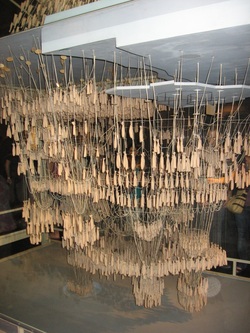It's been forever since my last post! It's been a busy semester so far, with a new curriculum rollout and some good research stuff going on. I wanted to take a quick moment and plug an awesome project that Shivani Janani, an honors program student I'm co-advising with Danielle Krcmar, will be working on next semester and ask for any resources that someone might know of.

I had heard a while back about an architect who designed his buildings by hanging small sandbags from string, projecting the resulting curves onto a wall using a lamp, and inverting the resulting traces to form the rough blueprint. The genius here is that the hanging strings form catenaries; before the era of cheap computing, these would've been tough to reliably and faithfully render by hand without such an innovative method.
Shivani recently got in touch with me, saying that she wanted to study for her honors thesis the connection of mathematics and architecture in Antoni Gaudi's work. I thought I'd never heard of the guy. A quick search shows that he's exactly the architect that I already admired from his catenary work. What a great coincidence!
As it turns out, catenaries are just one of the amazing mathematical shapes that Gaudi used in his work. He really dug deep in the ol' mathematical bullpen, calling up helicoids, hyperboloids, and some of their even more esoteric mathematical cousins. To cap it all off, he tossed a magic square (sort of; his has repeat entries) on the side of his most famous work, the Sagrada Familia church. Who was this guy?
I'm so excited that Shivani's going to unravel some of this fascinating story. She's currently trying to whittle such a big space down to a manageable project. If anyone has interesting leads, whether on mathematics in architecture, a good primer on the mathematical nature of some of these ruled surfaces, or on Gaudi himself, I'm sure she would be appreciative.
Shivani recently got in touch with me, saying that she wanted to study for her honors thesis the connection of mathematics and architecture in Antoni Gaudi's work. I thought I'd never heard of the guy. A quick search shows that he's exactly the architect that I already admired from his catenary work. What a great coincidence!
As it turns out, catenaries are just one of the amazing mathematical shapes that Gaudi used in his work. He really dug deep in the ol' mathematical bullpen, calling up helicoids, hyperboloids, and some of their even more esoteric mathematical cousins. To cap it all off, he tossed a magic square (sort of; his has repeat entries) on the side of his most famous work, the Sagrada Familia church. Who was this guy?
I'm so excited that Shivani's going to unravel some of this fascinating story. She's currently trying to whittle such a big space down to a manageable project. If anyone has interesting leads, whether on mathematics in architecture, a good primer on the mathematical nature of some of these ruled surfaces, or on Gaudi himself, I'm sure she would be appreciative.

 RSS Feed
RSS Feed
